As conscientious pet owners, it is crucial to be aware of the potential risks associated with common household products when it comes to our feline companions.
Baking soda, often touted for its versatility, raises concerns regarding its safety for cats. While it may seem innocuous, the implications of its usage in a cat-friendly environment warrant careful consideration.
Understanding the nuances of how baking soda interacts with cats and the precautions necessary to ensure their well-being is paramount. To navigate this aspect of pet care effectively, a closer examination of the safety aspects surrounding baking soda and its implications for cats becomes imperative.
Key Takeaways
- Baking soda ingestion can be dangerous for cats due to their size.
- Contact a vet immediately if baking soda is ingested.
- Monitor for signs of toxicity like vomiting.
- Keep baking soda inaccessible to prevent accidental ingestion.
What Is Baking Soda?
In the realm of household products, baking soda stands as a versatile compound known for its myriad applications. Also known as sodium bicarbonate, baking soda is a fine white powder with alkaline properties.
Beyond its role in baking as a leavening agent, it serves as a gentle abrasive cleaner and deodorizer. Its ability to neutralize odors makes it a popular choice for freshening up various surfaces in the home.
Baking soda is also valued for its eco-friendly nature, offering a non-toxic alternative to harsh chemical cleaners. Whether used in cooking, cleaning, or even personal care, baking soda's versatility and effectiveness have made it a staple in many households.
Baking Soda's Reaction With Acids
Having established baking soda's versatile properties and common uses, it's imperative to explore its interaction with acids to understand its chemical behavior comprehensively. Baking soda, or sodium bicarbonate, reacts with acids to produce carbon dioxide gas, water, and salt. This reaction is commonly observed in baking, where the acid in ingredients like buttermilk or vinegar reacts with baking soda to create bubbles, causing the dough to rise.
The neutralization reaction between baking soda and acids helps in balancing flavors and textures in various recipes. Understanding this chemical reaction is essential for successful baking outcomes and efficient cleaning processes, where baking soda's acidic interactions contribute to its effectiveness as a natural cleaner.
Baking Soda in Baking
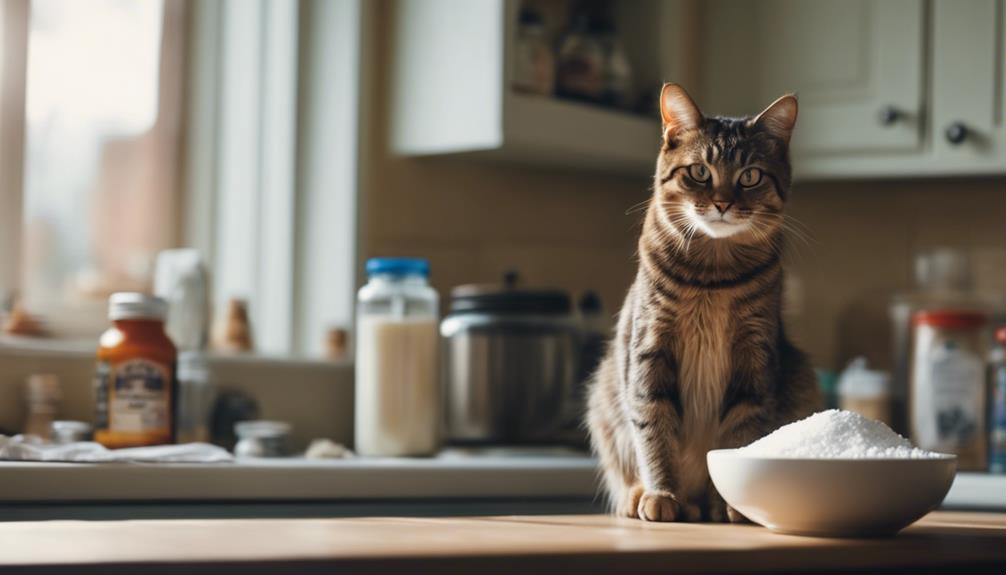
The incorporation of baking soda in baking recipes enhances leavening processes and contributes to the desired texture and flavor profiles of various baked goods.
When combined with acidic ingredients like buttermilk or vinegar, baking soda reacts to produce carbon dioxide gas, causing dough or batter to rise. This reaction results in light and fluffy cakes, cookies, and quick breads.
Baking soda is a versatile ingredient that not only helps baked goods rise but also aids in browning crusts and neutralizing acidic flavors. It is crucial to follow recipes accurately when using baking soda to achieve the intended results in your baked creations.
Dangers of Baking Soda for Cats
When considering the presence of baking soda in household settings, particularly in baking recipes where its leavening properties are utilized, it is important to acknowledge the potential dangers it poses to cats if ingested unintentionally. Cats are curious creatures and may accidentally consume baking soda, leading to various risks. Below is a table outlining the dangers of baking soda for cats:
| Dangers of Baking Soda for Cats | Effects |
|---|---|
| Ingestion in Large Quantities | Can lead to electrolyte imbalances |
| Potential Attraction to Taste | Cats may be drawn to its salty flavor |
| Toxicity Symptoms | Gas, vomiting, and other signs of toxicity |
It is crucial to keep baking soda out of reach of cats to prevent such incidents and ensure their safety.
Cats' Attraction to Baking Soda
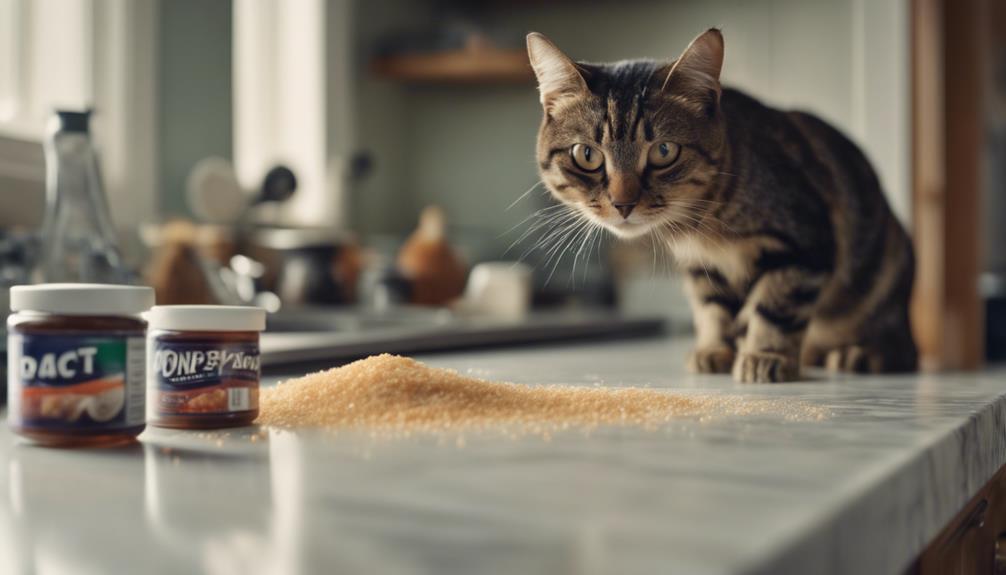
Cats exhibit a notable curiosity towards the salty taste of baking soda, making them potentially attracted to its presence in household settings. This attraction can pose risks to their health if they ingest it accidentally.
To evoke emotion in the audience, consider the following:
- The innocent curiosity of a cat exploring new scents and tastes.
- The concern of a pet owner seeing their beloved feline showing interest in potentially harmful substances.
- The importance of creating a safe environment for our furry companions.
- The fear of the unknown consequences if a cat consumes baking soda.
- The relief and reassurance of knowing how to prevent such incidents and take quick action if needed.
Effects of Baking Soda Ingestion
Ingestion of baking soda by felines can result in adverse health effects requiring immediate veterinary attention. Cats are susceptible to electrolyte imbalances when exposed to large quantities of baking soda. Signs of toxicity, such as gas or vomiting, may indicate ingestion and should prompt contacting a veterinarian promptly.
It's crucial to keep baking soda out of reach to prevent accidental ingestion. Even though cats may be less likely to ingest it compared to dogs, precautions should still be taken. If ingestion occurs, providing fresh water to dilute the effects is recommended.
Immediate Actions if Ingested
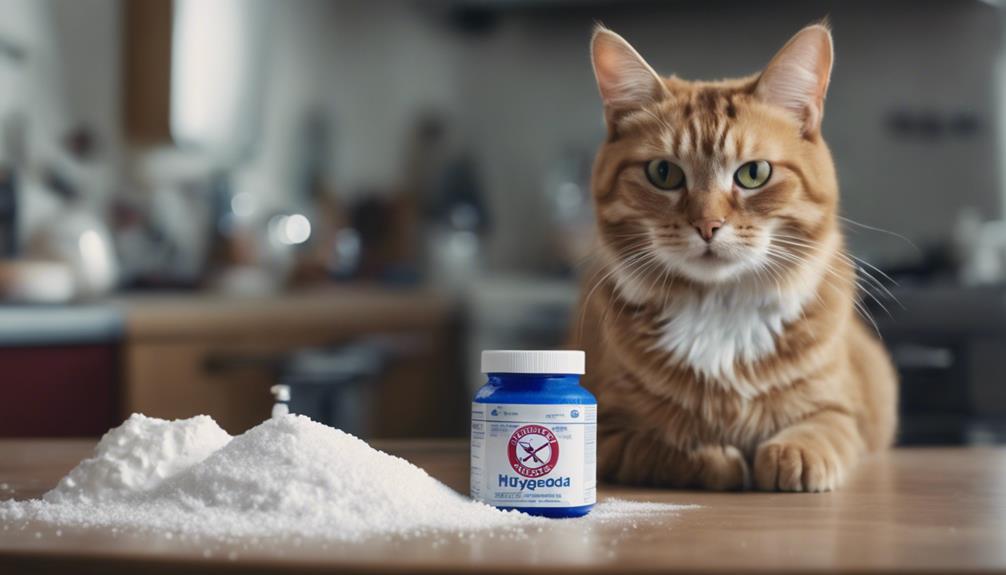
Upon suspecting or confirming baking soda ingestion by a cat, swift action is imperative to mitigate potential health risks and ensure the well-being of the feline.
Here are some immediate actions to take:
- Contact a veterinarian immediately: Professional guidance is crucial.
- Monitor for signs of toxicity: Watch for symptoms like gas or vomiting.
- Provide fresh water: Help dilute the effects by encouraging the cat to drink.
- Seek early intervention: Toxic effects may not be immediate, so prompt action is vital.
- Avoid home remedies: Refrain from administering anything without professional advice to prevent further harm.
Signs of Baking Soda Toxicity
Recognizing the signs of baking soda toxicity in felines is crucial for prompt intervention and care. Cats are sensitive animals, and even a small amount of baking soda can lead to harmful effects. Below is a table outlining common signs of baking soda toxicity in cats:
| Signs of Toxicity | Description |
|---|---|
| Vomiting | Continuous or severe vomiting |
| Diarrhea | Frequent loose stools |
| Abdominal Pain | Sensitivity to touch in the belly area |
| Lethargy | Unusual tiredness or lack of energy |
If you notice any of these signs in your cat after potential exposure to baking soda, seek veterinary assistance immediately for proper evaluation and treatment.
Importance of Fresh Water
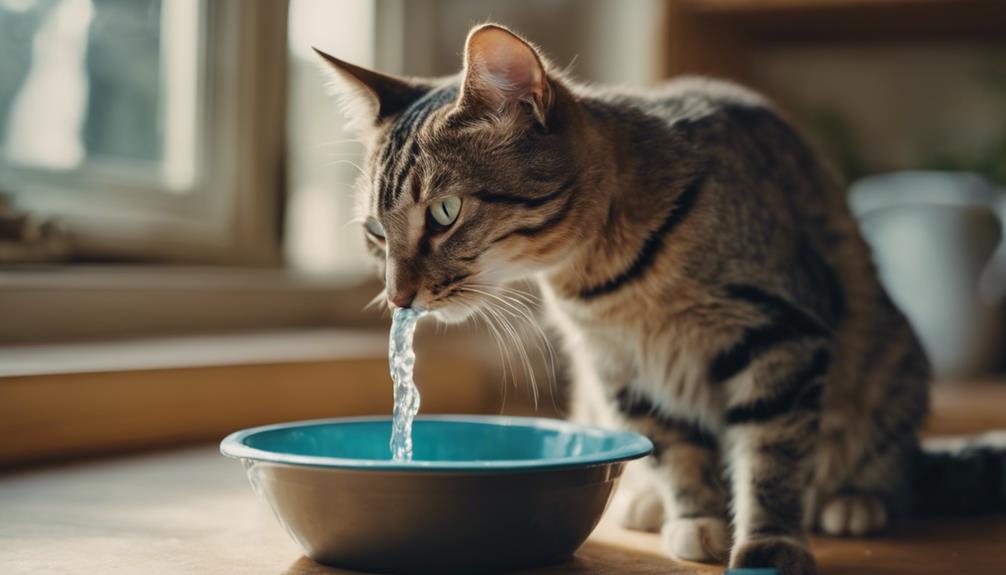
Adequate hydration is essential for maintaining the overall health and well-being of cats. Providing fresh water for your feline friend is crucial for their vitality and longevity. Here are some emotional reminders of the importance of fresh water for your beloved cat:
- Water is the elixir of life, keeping your cat's body functioning optimally.
- Dehydration can lead to serious health issues, causing discomfort and distress.
- Imagine the joy in seeing your cat happily lapping up fresh, clean water.
- Your cat relies on you to ensure their water bowl is always filled and accessible.
- Show your love by regularly refreshing their water source, a simple act with profound effects on their health and happiness.
Safe Use in Cat Litter
Ensuring the safety of your cat extends to every aspect of their environment, including the choice and use of cat litter. When it comes to using baking soda in cat litter, it can be a helpful addition. Baking soda is known for its odor-neutralizing properties, which can be beneficial in controlling litter box smells.
Many commercially available cat litters already contain baking soda for this reason. However, if you choose to add baking soda to your cat's litter box yourself, ensure that your cat does not ingest it. Monitor your cat's behavior around the litter box and consult with your veterinarian if you have any concerns.
Risks of Baking Soda on Cat Beds
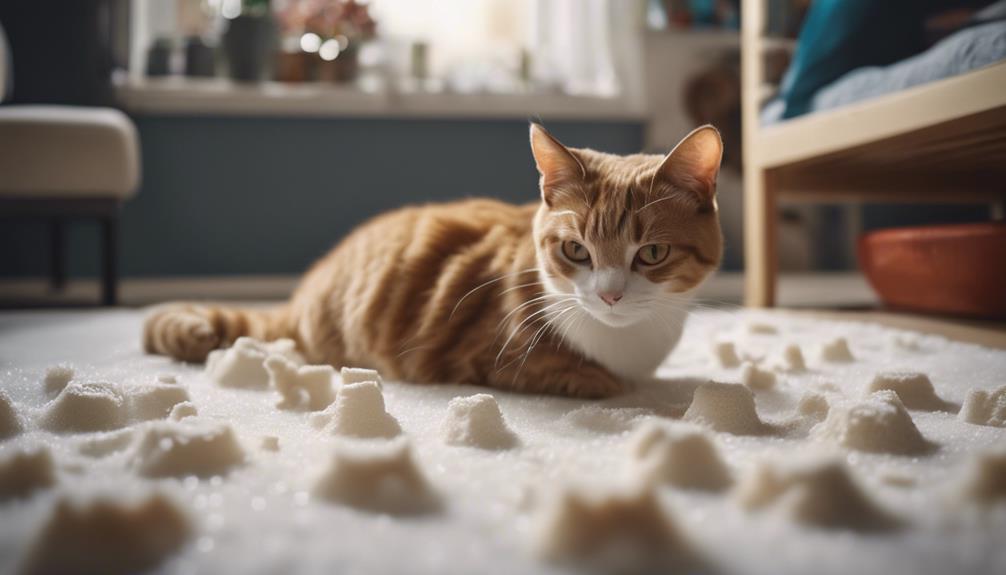
Using baking soda on cat beds may pose potential risks to feline health and safety.
- Risk of Ingestion: Cats may lick or ingest baking soda while grooming, leading to digestive issues.
- Respiratory Irritation: Fine particles of baking soda can be inhaled by cats, causing respiratory distress.
- Skin Sensitivity: Contact with baking soda may irritate a cat's skin, leading to discomfort.
- Allergic Reactions: Cats, like humans, can have allergic reactions to certain substances, including baking soda.
- Toxicity Concerns: Ingesting large amounts of baking soda can result in toxic effects on a cat's system, requiring immediate veterinary care.
Protect your feline friend by avoiding the use of baking soda on their beds to ensure their well-being and safety.
Carpet Deodorizing Safety Tips
When considering carpet deodorizing in your home, it is essential to prioritize the safety of your feline companions by being mindful of potential risks and taking preventative measures.
While baking soda can be a useful tool for removing odors from carpets, it's crucial to ensure that your cat is not harmed in the process. To safely deodorize your carpet, make sure to thoroughly vacuum the area to remove any baking soda residue before allowing your cat access.
This step is vital as cats may come into contact with the baking soda while grooming, potentially leading to ingestion. By taking these precautions, you can enjoy a fresh-smelling home without compromising your cat's well-being.
Baking Soda for Flea Control
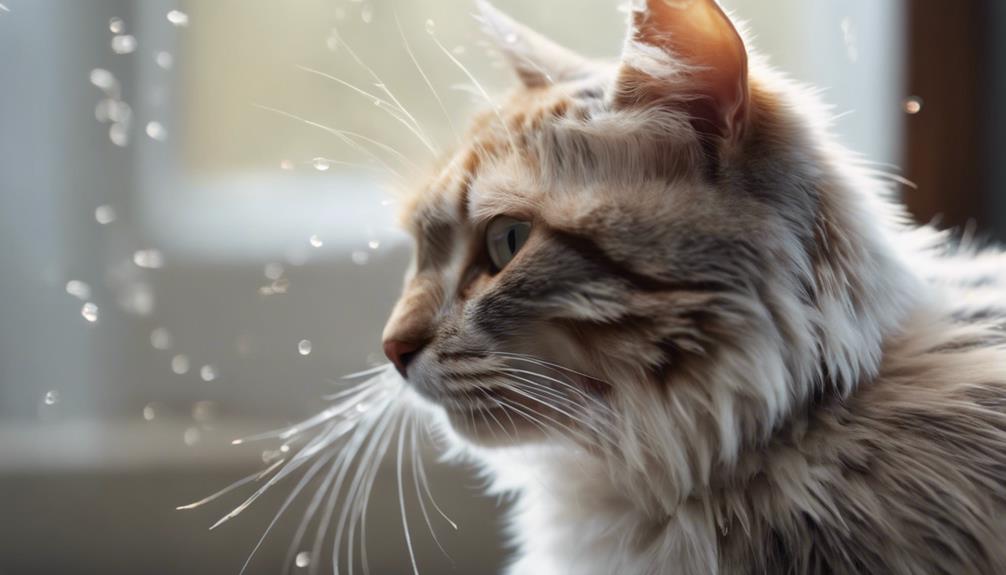
To address flea infestations in your home, incorporating baking soda as a natural remedy can be a method worth considering for controlling these pests.
- Gentle Approach: Baking soda offers a non-toxic alternative for flea control.
- Family-Friendly: Safe for households with children and multiple pets.
- Environmentally Conscious: Reduces the need for harsh chemicals in your living space.
- Cost-Effective: A budget-friendly option for flea management.
- Peace of Mind: Provides a sense of security knowing you're using a safer method.
Risks of DIY Cat Toothpaste
Considering the potential risks associated with homemade cat toothpaste, it is essential for cat owners to be aware of the dangers posed by DIY dental care products for their feline companions.
While the idea of creating your own toothpaste may seem harmless, certain ingredients like baking soda can be harmful if ingested by cats. Baking soda, often a key component in DIY toothpaste recipes, can cause issues such as electrolyte imbalances if consumed in large quantities.
Cats may be attracted to the taste of homemade toothpaste and inadvertently swallow it during the brushing process. To ensure the safety and well-being of your cat, it is best to opt for toothpaste specifically formulated for feline dental care and consult with a veterinarian for the most suitable oral hygiene products.
Conclusion
In conclusion, while baking soda can be a useful household product, it poses potential risks to cats if not used carefully. Just as we must tread carefully around a delicate flower to avoid damaging its petals, so too must we handle baking soda cautiously around our feline companions to protect their well-being.
By being mindful of the dangers and taking necessary precautions, pet owners can ensure a safe and harmonious environment for their beloved cats.




